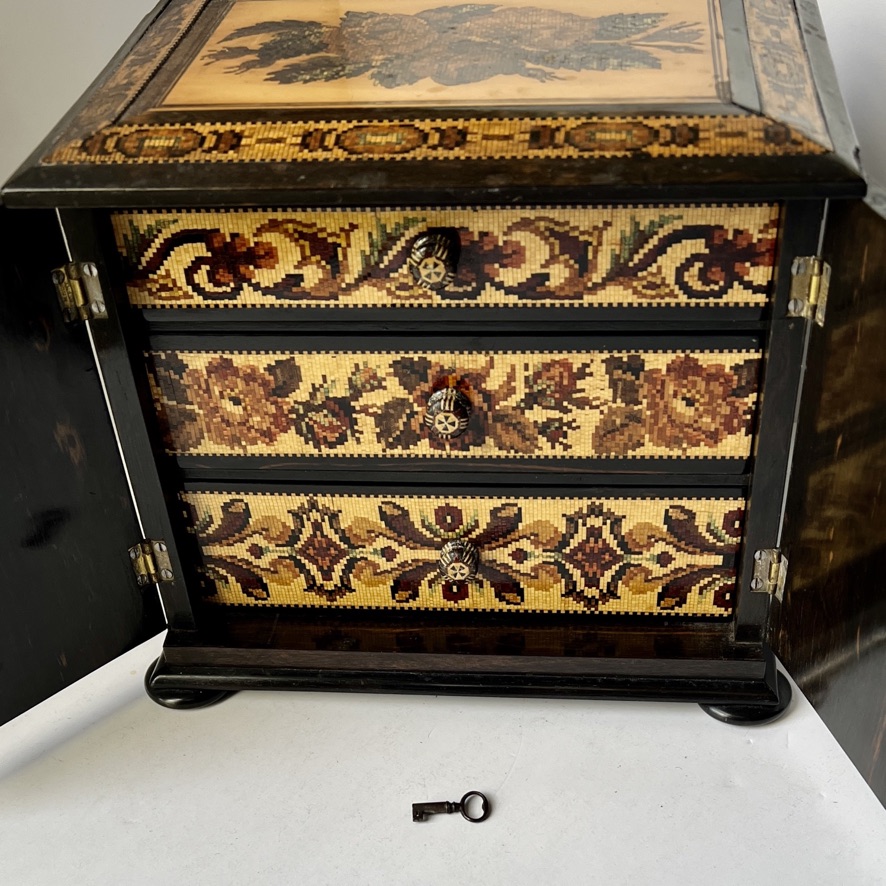
Tunbridge Ware Makers No 6. Edmond Nye
October 31st, 2024
Edmond Nye’s Techniques and Innovations.
Edmund Nye was not just a craftsman but also an innovator within the field. He employed advanced marquetry techniques, which involved cutting and fitting pieces of wood together to create detailed images and patterns. His ability to blend different woods allowed for a rich diversity of color and texture in his work.
In addition to traditional designs, Nye experimented with new motifs, including scenes that depicted local landmarks and nature. His pieces often featured intricate borders and personalized inscriptions, making them special gifts or keepsakes for tourists.
The Workshop and Community
Nye operated within a community of craftsmen who shared techniques and ideas. This collaborative environment fostered creativity and helped elevate Tunbridge Ware’s status. The workshops were often family-run, and Nye’s family may have also been involved in the craft, contributing to the legacy of Tunbridge Ware.
Market and Popularity
During Nye’s time, Tunbridge Ware gained immense popularity, particularly among the upper classes and tourists. The items were often sold in local shops and at fairs, and they became emblematic of the artisanal craftsmanship that characterized the region. Nye’s work, noted for its quality and artistry, contributed to the overall reputation of Tunbridge Ware as a luxurious and desirable product.
Preservation of Craft
Today, Tunbridge Ware is recognized as an important part of British decorative arts, and efforts are made to preserve the techniques and designs associated with it. Artisans continue to draw inspiration from the works of craftsmen like Edmund Nye, ensuring that the traditions of this unique craft live on.
Legacy and Collectibility
Nye’s pieces are highly collectible today, often fetching high prices at auctions and antique shops. Collectors value his craftsmanship and the historical significance of his work. Museums and galleries also feature Tunbridge Ware in exhibitions, highlighting its artistic and cultural importance.
Historical Context of Tunbridge Ware
Tunbridge Ware emerged during a time when the Industrial Revolution was transforming England. As manufacturing processes became more mechanized, traditional crafts began to be seen as valuable for their artistry and uniqueness. Tunbridge Wells, with its natural beauty and therapeutic springs, attracted a wealthy clientele seeking luxury and leisure, creating a market for handmade goods.
The Craftsmanship of Tunbridge Ware
The process of creating Tunbridge Ware is intricate and labor-intensive. Craftsmen like Nye would select high-quality woods and meticulously cut them into thin veneers. These veneers were then glued onto a core, often made of a different wood, and shaped into various forms. The final piece would be polished to enhance the natural beauty of the wood grains.
Key Techniques.
1.Marquetry. This technique involves creating patterns by fitting together pieces of wood of different colors and types, resulting in detailed designs.
2. Boulle Work. Some pieces incorporated elements of Boulle work, which uses brass and tortoiseshell for contrast.
3. Inlaying and Carving. Craftsmen would also use inlays and carvings to add depth and texture to their designs, often incorporating motifs that reflected the natural surroundings of Tunbridge Wells.
The Role of Edmund Nye
Edmund Nye was a master craftsman who refined these techniques, producing pieces that were not only functional but also works of art. His attention to detail and commitment to quality helped to set his work apart from that of other artisans.
Nye’s Notable Works.
Boxes. Decorative boxes were among the most popular items, often used for storing jewelry or letters. Games and Puzzles. Nye also created game boards and puzzles, which were especially popular among families during the Victorian era.
Personalized Items. Custom pieces for special occasions, such as weddings or anniversaries, showcased his ability too cater to individual tastes.










Cultural Significance
The success of Tunbridge Ware can be attributed to its cultural significance. It represented not just a souvenir of a visit but also a connection to the artisan’s skill and the local landscape. Many pieces featured local landmarks or flora, creating a sense of place and nostalgia for visitors.
Collecting Tunbridge Ware
Today, collectors seek out original pieces from the 19th century, with a focus on items made by known craftsmen like Edmund Nye. The rarity and condition of the items, along with their provenance, can significantly influence their value. Many collectors appreciate the craftsmanship and the story behind each piece, making Tunbridge Ware a popular subject in antique shows and exhibitions.
Preservation Efforts
There has been a resurgence of interest in traditional crafts, including Tunbridge Ware, as artisans and organizations work to preserve these techniques. Workshops, classes, and exhibitions help to educate the public about the history and artistry of Tunbridge Ware. Some contemporary craftsmen draw inspiration from historic designs while incorporating modern techniques and materials.
Conclusion
Edmund Nye’s legacy is interwoven with the rich tapestry of Tunbridge Ware’s history. His contributions not only shaped the craft during his lifetime but also laid the groundwork for its appreciation in contemporary culture. The beauty and uniqueness of Tunbridge Ware continue to resonate, reflecting a time when craftsmanship was celebrated and valued. Through the preservation of this art form, Nye’s spirit and dedication to quality endure, inspiring future generations of artisans and collectors alike.



